The solid terpene resin market is valued at USD 215.4 million in 2025 and is projected to reach USD 354.3 million by 2035, growing at a CAGR of 5.2% during the assessment period. This expansion, representing an absolute increase of USD 138.9 million and a 1.6X rise in market size, places supply-side capacity and feedstock availability at the center of industry performance. Production scalability depends heavily on reliable sourcing of natural raw materials such as pine oleoresins, citrus peels, and other terpene-rich biomass streams. Manufacturers are expected to strengthen their supply base through backward integration into forestry, partnerships with citrus processors, and diversification of inputs to reduce over-reliance on traditional sources. Seasonal volatility and climate-related risks remain limiting factors, but advancements in extraction and valorization technologies are forecast to enhance yield stability.
Capacity expansions are already shaping the competitive landscape, with Asia-Pacific emerging as the fastest-growing hub due to low-cost feedstock access and favorable industrial policies. Global players are investing in bio-refineries specializing in terpene distillation and resin modification to meet demand across adhesives, coatings, and specialty chemicals. European suppliers, constrained by feedstock availability but guided by regulatory shifts toward bio-based solutions, are channeling resources into advanced processing technologies designed to maximize output per ton of raw material. In North America, capacity build-up is expected to follow demand growth in adhesives and packaging while relying on imports for citrus-derived feedstocks.
Feedstock competition with other industries, such as fragrances, flavors, and bio-based solvents, is also expected to tighten supply, potentially driving input cost escalation. This creates strong incentives for hybrid approaches, including partial substitution with synthetic terpene analogues or the use of circular feedstock strategies such as terpene recovery from industrial by-products. Research into precision fractionation and controlled polymerization is anticipated to unlock higher yields, mitigating supply bottlenecks.
The supply-side trajectory through 2035 will be defined by three pillars: scaling of terpene processing infrastructure, geographic diversification of raw material sources, and integration of technology-led extraction techniques. Producers that secure consistent raw material flows and leverage efficient production processes will be best positioned to capitalize on the 5.2% CAGR growth, while those exposed to feedstock volatility without integrated sourcing will face significant cost and margin pressures.
| Period | Primary Revenue Buckets | Share | Notes |
|---|---|---|---|
| Today | Softening Point <110°C resins | 62% | Traditional processing, established adhesive applications |
| Softening Point 110-120°C resins | 28% | Medium-temperature applications, coating systems | |
| Softening Point >120°C resins | 10% | High-temperature applications, specialty uses | |
| Future (3-5 yrs) | Advanced low-temperature systems | 55-58% | Enhanced processing control, improved compatibility |
| Medium-temperature specialty resins | 22-25% | Coating optimization, adhesive enhancement | |
| Ink and paint applications | 15-18% | Printing industry, decorative coatings | |
| Hot melt adhesive systems | 8-12% | Industrial bonding, packaging applications | |
| Food industry applications | 5-8% | Food-grade formulations, packaging materials | |
| Rubber and tape applications | 3-6% | Elastic compounds, pressure-sensitive adhesives |
| Metric | Value |
|---|---|
| Market Value (2025) | USD 215.4 million |
| Market Forecast (2035) | USD 354.3 million |
| Growth Rate | 5.1% CAGR |
| Leading Softening Point | Softening Point <110°C |
| Primary Application | Ink, Paint, and Coatings Segment |
The market demonstrates strong fundamentals with low-temperature softening point resin systems capturing a dominant share through advanced processing properties and industrial application optimization. Ink, paint, and coatings applications drive primary demand, supported by increasing quality requirements and chemical industry modernization initiatives. Geographic expansion remains concentrated in developed markets with established chemical infrastructure, while emerging economies show accelerating adoption rates driven by industrial modernization initiatives and rising processing standards.
Primary Classification: The market segments by softening point into <110°C, 110-120°C, and >120°C categories, representing the evolution from low-temperature processing resins to high-performance thermal stability solutions for comprehensive industrial application optimization.
Secondary Classification: Application segmentation divides the market into ink/paint/coatings, hot melt and pressure-sensitive adhesives, rubber and tape, food industry, and others, reflecting distinct requirements for thermal performance, processing compatibility, and application-specific specifications.
Tertiary Classification: End-use segmentation covers adhesive manufacturers, coating producers, printing companies, food packaging companies, and chemical processors, while distribution channels span direct sales, chemical distributors, and specialized industrial suppliers.
Regional Classification: Geographic distribution covers North America, Latin America, Western Europe, Eastern Europe, East Asia, South Asia Pacific, and Middle East & Africa, with developed markets leading adoption while emerging economies show accelerating growth patterns driven by chemical industry modernization programs.
The segmentation structure reveals processing evolution from traditional low-temperature resins toward sophisticated high-temperature solutions with enhanced thermal stability capabilities, while application diversity spans from printing inks to industrial adhesives requiring precision resin solutions.
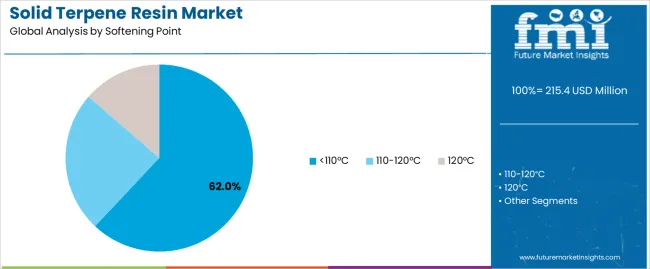
Market Position: Low-temperature softening point resin systems command the leading position in the solid terpene resin market with 62% market share through proven processing technologies, including enhanced flow properties, thermal compatibility, and application optimization that enable chemical manufacturers to achieve optimal processing performance across diverse industrial and specialty applications.
Value Drivers: The segment benefits from chemical industry preference for versatile processing systems that provide reliable flow characteristics, processing flexibility, and operational compatibility without requiring high-temperature processing infrastructure. Advanced resin formulation features enable enhanced compatibility, consistent quality properties, and integration with existing production systems, where processing efficiency and application versatility represent critical operational requirements.
Competitive Advantages: Low-temperature resin systems differentiate through proven processing reliability, versatile application characteristics, and integration with established chemical processing systems that enhance facility effectiveness while maintaining optimal quality standards suitable for diverse industrial applications.
Key market characteristics:
Medium-temperature softening point resin systems maintain a 28% market position in the solid terpene resin market due to their balanced performance advantages and processing flexibility benefits. These materials appeal to facilities requiring moderate-temperature processing solutions with enhanced thermal stability profiles for specialized operations. Market growth is driven by coating industry expansion, emphasizing performance resin solutions and operational efficiency through optimized thermal designs.
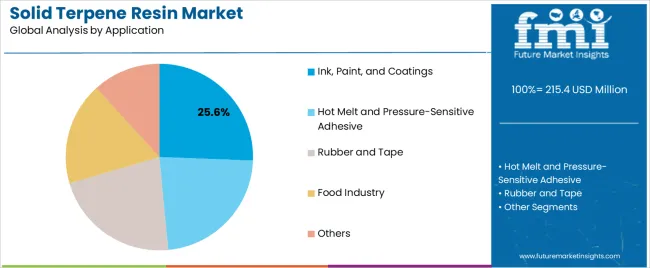
Market Context: Ink, paint, and coatings applications demonstrate strong growth in the solid terpene resin market with 6.4% CAGR and 25.6% market share due to widespread adoption of bio-based resin systems and increasing focus on coating excellence, processing cost efficiency, and performance applications that maximize resin effectiveness while maintaining quality standards.
Appeal Factors: Coating manufacturers prioritize resin reliability, processing consistency, and integration with existing production infrastructure that enables coordinated resin operations across multiple product lines. The segment benefits from substantial coating industry investment and modernization programs that emphasize the acquisition of premium resins for performance differentiation and application optimization.
Growth Drivers: Coating industry expansion programs incorporate terpene resins as essential components for performance enhancement, while printing industry growth increases demand for resin capabilities that comply with quality standards and minimize processing complexity.
Market Challenges: Varying application requirements and processing complexity may limit resin standardization across different coating or printing scenarios.
Application dynamics include:
Hot melt and pressure-sensitive adhesive applications capture 24% market share through specialized bonding requirements in packaging applications, industrial assembly, and adhesive applications. These facilities demand performance resins capable of supporting temperature requirements while providing bonding strength access and processing compatibility capabilities.
Rubber and tape applications account for 18% market share, including tire manufacturing, industrial rubber products, and tape production requiring performance resin capabilities for flexibility optimization and processing effectiveness.
Market Context: Adhesive Manufacturers dominate the market with 5.8% CAGR, reflecting the primary demand source for solid terpene resin technology in bonding applications and processing standardization.
Business Model Advantages: Adhesive Manufacturers provide direct market demand for specialized resin systems, driving formulation development and performance optimization while maintaining quality control and processing consistency requirements.
Operational Benefits: Adhesive Manufacturer applications include performance enhancement, processing efficiency, and quality assurance that drive consistent demand for resin systems while providing access to latest formulation technologies.
| Category | Factor | Impact | Why It Matters |
|---|---|---|---|
| Driver | Chemical industry growth & bio-based material demand (environmental regulations, performance requirements) | ★★★★★ | Growing chemical processing market requires bio-based resins with enhanced processing capabilities and thermal properties proven effective across industrial applications. |
| Driver | Processing standards advancement & quality requirements (thermal stability, compatibility) | ★★★★★ | Transforms resin requirements from "basic chemicals" to "performance solutions"; operators that offer quality resins and processing features gain competitive advantage. |
| Driver | Specialty applications market growth & performance enhancement (adhesives, coatings) | ★★★★☆ | Specialty manufacturers need distinctive, high-performance resins; demand for exclusive and superior resin solutions expanding addressable market. |
| Restraint | Cost pressures & raw material constraints (especially for specialty grades) | ★★★★☆ | Smaller chemical processors defer resin upgrades; increases price sensitivity and slows premium resin adoption in cost-conscious markets. |
| Restraint | Alternative resin options competition (synthetic resins, petroleum-based alternatives) | ★★★☆☆ | Standard synthetic alternatives offer established supply chains and lower costs, potentially limiting terpene resin adoption in traditional applications. |
| Trend | Processing technology integration & performance enhancement (thermal control, compatibility optimization) | ★★★★★ | Advanced processing properties, thermal optimization, and performance analytics transform operations; technology integration and performance enhancement become core value propositions. |
| Trend | Customization & application-specific solutions (grade development, processing optimization) | ★★★★☆ | Custom resins for specific applications and processing requirements; specialized formulations and targeted performance capabilities drive competition toward customization solutions. |
The solid terpene resin market demonstrates varied regional dynamics with Growth Leaders including China (6.9% growth rate) and India (6.4% growth rate) driving expansion through chemical industry development initiatives and processing modernization. Steady Performers encompass Germany (5.9% growth rate), Brazil (5.4% growth rate), and developed regions, benefiting from established chemical industries and specialty resin adoption. Mature Markets feature United States (4.8% growth rate), United Kingdom (4.3% growth rate), and Japan (3.8% growth rate), where chemical advancement and processing standardization requirements support consistent growth patterns.
Regional synthesis reveals East Asian markets leading adoption through chemical expansion and processing development, while North American countries maintain steady expansion supported by resin technology advancement and industrial standardization requirements. European markets show strong growth driven by specialty applications and quality integration trends.
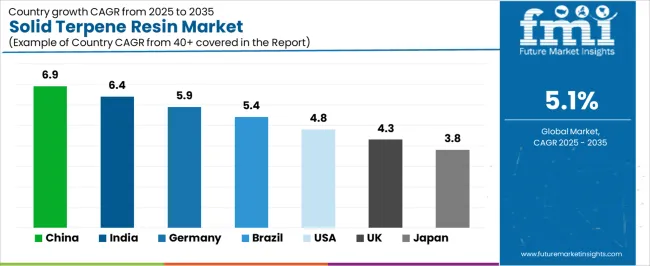
| Region/Country | 2025-2035 Growth | How to win | What to watch out |
|---|---|---|---|
| China | 6.9% | Focus on volume production solutions | Regulatory changes; local competition |
| India | 6.4% | Lead with cost-effective manufacturing | Import restrictions; quality barriers |
| Germany | 5.9% | Provide premium quality resins | Over-regulation; lengthy approvals |
| Brazil | 5.4% | Offer value-oriented solutions | Currency fluctuations; import duties |
| United States | 4.8% | Push technology integration | Compliance costs; scaling challenges |
| United Kingdom | 4.3% | Focus on specialty applications | Economic impacts; resin costs |
| Japan | 3.8% | Emphasize quality manufacturing | Traditional preferences; adoption rates |
China establishes fastest market growth through aggressive chemical industry development programs and comprehensive processing infrastructure expansion, integrating advanced terpene resin systems as standard components in adhesive facilities and coating installations. The country's 6.9% growth rate reflects government initiatives promoting chemical infrastructure and domestic resin capabilities that mandate the use of bio-based resin systems in manufacturing and processing facilities. Growth concentrates in major chemical hubs, including Guangdong, Jiangsu, and Shandong, where chemical development showcases integrated resin systems that appeal to manufacturers seeking processing optimization capabilities and performance applications.
Chinese manufacturers are developing cost-effective resin solutions that combine domestic production advantages with advanced processing features, including enhanced thermal control and improved compatibility capabilities. Distribution channels through chemical suppliers and specialty distributors expand market access, while government support for chemical development supports adoption across diverse manufacturing and processing segments.
Strategic Market Indicators:
In Mumbai, Chennai, and Gujarat, chemical facilities and processing operators are implementing bio-based terpene resin systems as standard materials for manufacturing and processing optimization applications, driven by increasing government chemical investment and industrial modernization programs that emphasize the importance of performance capabilities. The market holds a 6.4% growth rate, supported by government chemical initiatives and industrial development programs that promote bio-based resin systems for manufacturing and processing facilities. Indian operators are adopting resin systems that provide consistent processing performance and compatibility features, particularly appealing in industrial regions where chemical processing and operational excellence represent critical business requirements.
Market expansion benefits from growing chemical capabilities and international technology partnerships that enable domestic production of bio-based resin systems for manufacturing and processing applications. Technology adoption follows patterns established in chemical equipment, where reliability and performance drive procurement decisions and operational deployment.
Market Intelligence Brief:
Germany's advanced chemical market demonstrates sophisticated terpene resin deployment with documented processing effectiveness in manufacturing applications and specialty facilities through integration with existing chemical systems and processing infrastructure. The country leverages engineering expertise in chemicals and processing systems integration to maintain a 5.9% growth rate. Chemical centers, including North Rhine-Westphalia, Bavaria, and Baden-Württemberg, showcase premium installations where resin systems integrate with comprehensive chemical platforms and facility management systems to optimize processing performance and operational effectiveness.
German manufacturers prioritize system quality and EU compliance in resin development, creating demand for premium systems with advanced features, including facility integration and processing optimization systems. The market benefits from established chemical infrastructure and a willingness to invest in bio-based resin technologies that provide long-term operational benefits and compliance with international chemical standards.
Market Intelligence Brief:
Brazil's market expansion benefits from diverse chemical demand, including industrial modernization in São Paulo and Rio de Janeiro, manufacturing facility upgrades, and government chemical programs that increasingly incorporate bio-based resin solutions for processing applications. The country maintains a 5.4% growth rate, driven by rising industrial activity and increasing recognition of bio-based resin benefits, including precise processing control and enhanced operational effectiveness.
Market dynamics focus on cost-effective resin solutions that balance processing performance with affordability considerations important to Brazilian chemical operators. Growing industrial activity creates continued demand for modern resin systems in new chemical infrastructure and facility modernization projects.
Strategic Market Considerations:
United States establishes market leadership through comprehensive chemical programs and advanced processing infrastructure development, integrating terpene resin systems across manufacturing and specialty applications. The country's 4.8% growth rate reflects established chemical industry relationships and mature resin technology adoption that supports widespread use of bio-based resin systems in manufacturing and processing facilities. Growth concentrates in major chemical centers, including Texas, Louisiana, and California, where resin technology showcases mature deployment that appeals to chemical operators seeking proven processing capabilities and operational efficiency applications.
American chemical providers leverage established distribution networks and comprehensive technical support capabilities, including application development programs and technical support that create customer relationships and operational advantages. The market benefits from mature regulatory standards and chemical requirements that support resin system use while supporting technology advancement and processing optimization.
Market Intelligence Brief:
United Kingdom's chemical market demonstrates integrated terpene resin deployment with documented processing effectiveness in manufacturing applications and specialty facilities through integration with existing chemical systems and processing infrastructure. The country maintains a 4.3% growth rate, supported by chemical excellence programs and processing effectiveness requirements that promote bio-based resin systems for chemical applications. Manufacturing facilities across England, Scotland, and Wales showcase systematic installations where resin systems integrate with comprehensive chemical platforms to optimize processing performance and operational outcomes.
UK chemical providers prioritize system reliability and industry compatibility in resin procurement, creating demand for validated systems with proven processing features, including quality monitoring integration and performance optimization systems. The market benefits from established chemical infrastructure and excellence requirements that support resin technology adoption and operational effectiveness.
Market Intelligence Brief:
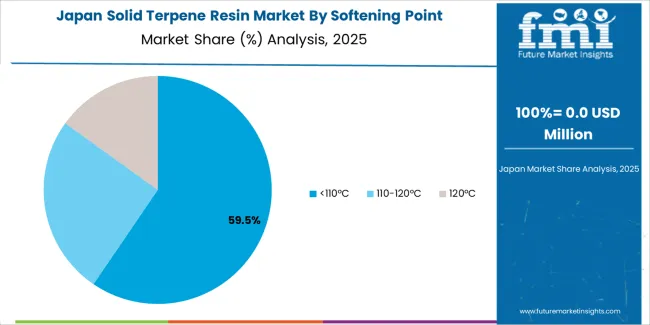
Japan's market growth benefits from precision chemical demand, including advanced manufacturing facilities in Tokyo and Osaka, quality integration, and processing enhancement programs that increasingly incorporate resin solutions for manufacturing applications. The country maintains a 3.8% growth rate, driven by chemical technology advancement and increasing recognition of precision resin benefits, including accurate processing control and enhanced manufacturing outcomes.
Market dynamics focus on high-precision resin solutions that meet Japanese quality standards and processing effectiveness requirements important to chemical operators. Advanced chemical technology adoption creates continued demand for sophisticated resin systems in manufacturing facility infrastructure and processing modernization projects.
Strategic Market Considerations:
The European solid terpene resin market is projected to grow from USD 47.8 million in 2025 to USD 80.7 million by 2035, registering a CAGR of 5.4% over the forecast period. Germany is expected to maintain its leadership position with a 42.1% market share in 2025, supported by its advanced chemical infrastructure and major processing centers.
United Kingdom follows with a 22.5% share in 2025, driven by comprehensive chemical programs and processing excellence development initiatives. France holds a 16.8% share through specialized chemical applications and processing compliance requirements. Italy commands a 11.2% share, while Spain accounts for 7.4% in 2025. The rest of Europe region is anticipated to gain momentum, expanding its collective share from 3.6% to 4.1% by 2035, attributed to increasing chemical adoption in Nordic countries and emerging processing facilities implementing chemical modernization programs.
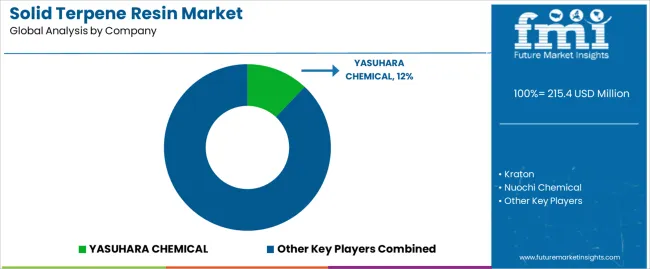
| Stakeholder | What they actually control | Typical strengths | Typical blind spots |
|---|---|---|---|
| Global brands | Distribution reach, broad product catalogs, brand recognition | Wide availability, proven quality, multi-region support | Product refresh cycles; customer dependency on brand validation |
| Technology innovators | Processing R&D; advanced resin technologies; enhanced performance properties | Latest technologies first; attractive ROI on processing effectiveness | Service density outside core regions; scaling complexity |
| Regional specialists | Local compliance, fast delivery, nearby customer support | "Close to customer" support; pragmatic pricing; local regulations | Technology gaps; talent retention in customer service |
| Full-service providers | Resin programs, technical services, application development | Lowest operational risk; comprehensive support | Service costs if overpromised; technology obsolescence |
| Niche specialists | Specialized applications, custom resins, technical services | Win premium applications; flexible configurations | Scalability limitations; narrow market focus |
| Item | Value |
|---|---|
| Quantitative Units | USD 215.4 million |
| Softening Point | <110°C, 110-120°C, >120°C |
| Application | Ink/Paint/Coatings, Hot Melt and Pressure-Sensitive Adhesive, Rubber and Tape, Food Industry, Others |
| End Use | Adhesive Manufacturers, Coating Producers, Printing Companies, Food Packaging Companies, Chemical Processors |
| Regions Covered | North America, Latin America, Western Europe, Eastern Europe, East Asia, South Asia Pacific, Middle East & Africa |
| Countries Covered | China, India, Germany, Brazil, United States, United Kingdom, Japan, Canada, France, Australia, and 25+ additional countries |
| Key Companies Profiled | YASUHARA CHEMICAL, Kraton, Nuochi Chemical, Guangxi Dinghong Resin, Ganzhou Taipu Chemical, Xiamen Well Chemical Industry |
| Additional Attributes | Dollar sales by softening point and application categories, regional adoption trends across East Asia, North America, and Western Europe, competitive landscape with chemical manufacturers and resin suppliers, industrial operator preferences for resin effectiveness and processing performance, integration with chemical platforms and processing management systems, innovations in resin technology and processing enhancement, and development of advanced resin solutions with enhanced thermal stability and operational optimization capabilities. |
The global solid terpene resin market is estimated to be valued at USD 215.4 million in 2025.
The market size for the solid terpene resin market is projected to reach USD 354.3 million by 2035.
The solid terpene resin market is expected to grow at a 5.1% CAGR between 2025 and 2035.
The key product types in solid terpene resin market are <110°c, 110-120°c and 120°c.
In terms of application, ink, paint, and coatings segment to command 25.6% share in the solid terpene resin market in 2025.






Full Research Suite comprises of:
Market outlook & trends analysis
Interviews & case studies
Strategic recommendations
Vendor profiles & capabilities analysis
5-year forecasts
8 regions and 60+ country-level data splits
Market segment data splits
12 months of continuous data updates
DELIVERED AS:
PDF EXCEL ONLINE
Solid Board Market Size and Share Forecast Outlook 2025 to 2035
Solid State Battery Silicon Carbon Negative Electrode Market Size and Share Forecast Outlook 2025 to 2035
Solid Control Equipment Market Size and Share Forecast Outlook 2025 to 2035
Solid-State Array Market Size and Share Forecast Outlook 2025 to 2035
Solid-State Power Amplifier Market Size and Share Forecast Outlook 2025 to 2035
Solid Vacuum Reclosers Market Size and Share Forecast Outlook 2025 to 2035
Solid State LiDAR Sensor Market Analysis Size and Share Forecast Outlook 2025 to 2035
Solid-State Lighting Market Size and Share Forecast Outlook 2025 to 2035
Global Solid Serum Market Size and Share Forecast Outlook 2025 to 2035
Solid State Drive Market Size and Share Forecast Outlook 2025 to 2035
Solid State Power Controller Market Size and Share Forecast Outlook 2025 to 2035
Solid State Lighting System Market Size and Share Forecast Outlook 2025 to 2035
Solid State Lasers Market Analysis - Growth & Forecast 2025 to 2035
Solid-State Cooling Market Analysis & Forecast by Type, Product, End-user Industry, and Region Through 2035
Solid White Films Market Analysis & Trends 2024-2034
Solid State Relays – Powering EVs & Industrial Automation
Solid Sulphur Market Growth – Trends & Forecast 2024-2034
Solid Bleached Board Market
Solid Oxide Fuel Cell Market
Solid Electrolyte Market

Thank you!
You will receive an email from our Business Development Manager. Please be sure to check your SPAM/JUNK folder too.
Chat With
MaRIA